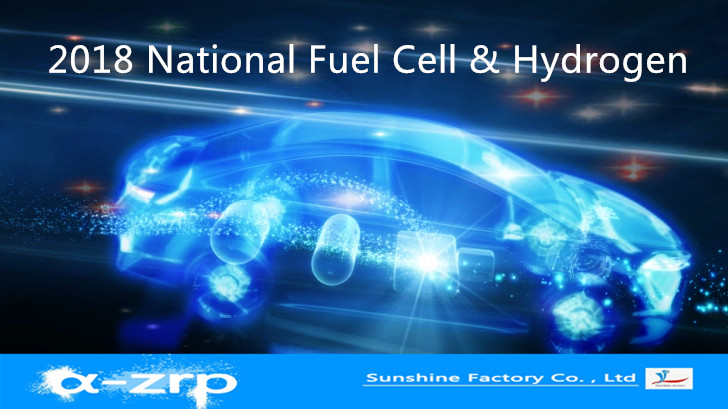Sunshine Factory, Co., Ltd. > Applications > ZrP for Fuel Cell, Lithium BatZrP for Fuel Cell, Lithium Bat
Exciting Inspiration from Design on 2018 National Fuel Cell & Hydrogen
A novel SPVDF/ZrP composite membrane was synthesized as proton exchange membrane for hydrogen production using electrochemical methanol reformation (ECMR).
Polymer electrolyte membrane (PEM)-based electrochemical methanol reformation has gained interest as a practical way to produce hydrogen than water electrolysis due to its low operating voltages.
Development of alternative PEM for this application is of considerable interest in order to reduce the cost as well as increase the system efficiency.
PVDF-co-HFP granules were defluorinated by alkali treatment followed by sulfonation using chlorosulfonic acid to prepare sulfonated polymer.
Inorganic zirconium phosphate (ZrP) was further added to increase proton conductivity. The membranes were characterized for their physicochemical properties, mechanical strength, and thermal stability. The enhancement in proton exchange capacity and water uptake with adequate dimensional stability was observed with dehydrofluorination and impregnation of ZrP.
A novel electrolyzer consisting of Pt-Ru/C as anode electrode, same format as anode as cathode electrode and the SPVDF/ZrP composite membrane was assembled and its performance was tested for hydrogen production. It was found that SPVDF/ZrP composite membrane showed good electrochemical cell performance of 0.65 V at 0.15 A cm−2 current density at ambient temperature and gives scope for operating ECMR cell at higher current densities for to increase the hydrogen production rate which is comparable to the performance of commercial Nafion® 117 membrane.


Follow WeChat


